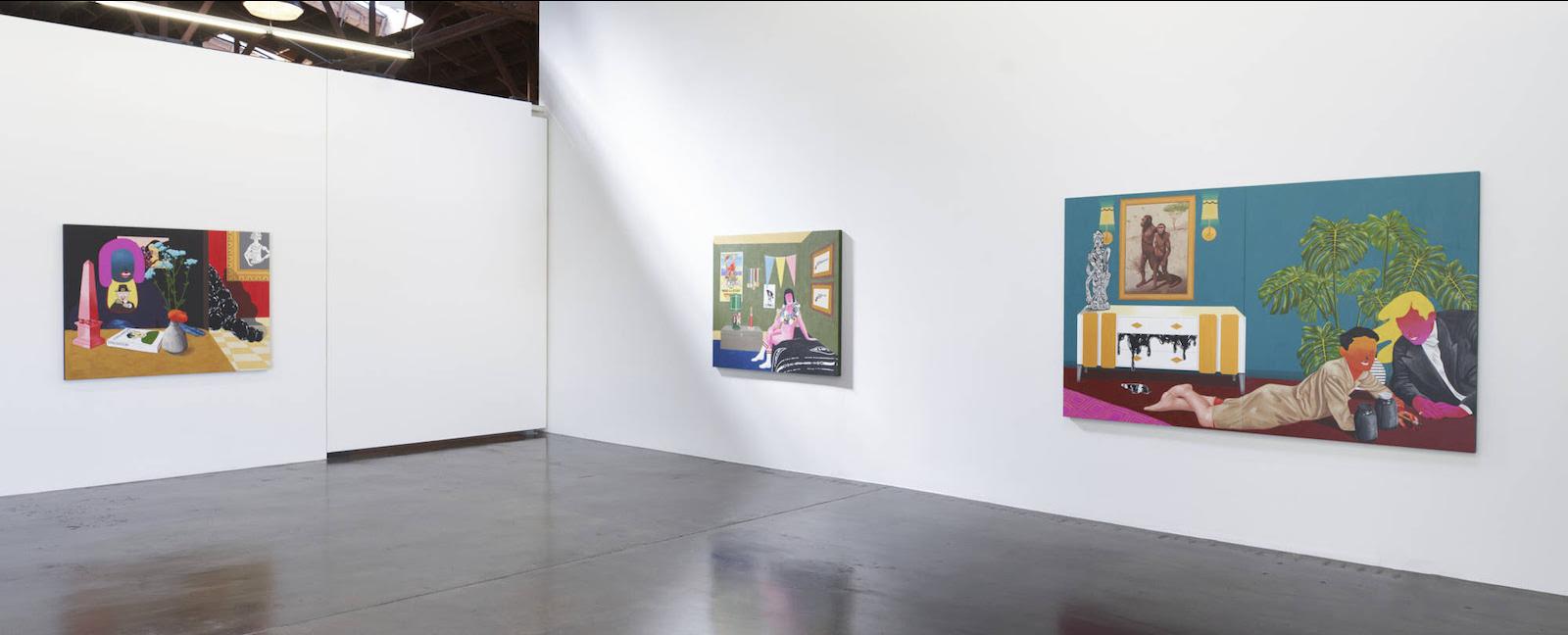
Irresistible Deception installation image.
SAN FRANCISCO — CULT Aimee Friberg Exhibitions is pleased to announce Irresistible Deception, a solo exhibition of new paintings and drawings by Los Angeles-based artist Chris Fallon, on view at CULT’s new home, located within Yves Behar’s fuseproject (1401 16th St., SanFrancisco). The exhibition runs from October 15 to December 11, 2021. Irresistible Deception is Fallon’s first solo presentation with CULT.
In this new body of work, Fallon—known for his striking images of ambiguous figures that both draw on and challenge existing traditions of portraiture—explores how the practice of collecting shapes the fashioning of domestic space. From the most lavish to the most impoverished of circumstances, the spaces of human habitation take form through the amassing of objects. Beyond the functional value of the objects we amass, collecting might serve a variety of unconscious purposes: exhibiting a material archive of wealth, documenting travel and performing worldliness, creating a narrative of personal achievement, or attempting to craft anesthetic sensibility ultimately tied to norms of gender, class, racial, religious, or national identity.
Fallon observes that collecting is a quotidian activity that appears practical but also evinces a form of compulsion or drive. In his paintings, human-like figures share space with the objects that come to define them — collections of memorabilia, cars, books, religious iconography, botanicals or art. Often the human figures recede into the background, ceding the space to representations in different registers: masks, sculptures, trophies, mirrors, and paintings within the painting.
In preparation for the exhibition, Fallon delved into the psychology of collecting, a practice with an ancient heritage. Psychoanalyst and art historian Werner Muensterberger writes that collecting is a “need-driven compensatory behavior where every new object effectively gives the notion of fantasized omnipotence.”Fallon adds, “We end up living vicariously through our possessions. We allow our objects to project a curated, aspirational image of ourselves to others, as well as back at ourselves.” The paintings in the exhibition reflect this phenomenon through a distinctly American lens, drawing on U.S. iconography while illuminating the strangeness — and the queerness—of its constitutive image-repertoire.
Human figures in Fallon’s paintings are relatively flat, while objects and plants are rendered with detailed definition. His painting style references formal portraiture and classical painting as well as cartoons and other so-called lowbrow art forms, positioning his work in an uneasy middle ground. Environments and figures in these pieces are familiar but there’s a tension in the skewed, garish way Fallon represents them. “When we hide behind our possessions and allow inanimate objects to define us, they inherently hold the dimensionality we feel we lack,” Fallon said. “I choose to show this literally.” The tone of the works veers between humor, emotional intensity, and nightmarishness. Sometimes the figures seem part-reptilian; at others, they are barely an outline, a citation or representational shorthand, as in a comic book. But while the paintings draw on familiar images, they translate them into a unique pictorial space that upends expectations and leaves the viewer unsettled.
In his exploration of formal strategies of portraiture, Fallon’s work also challenges American notions of masculinity and femininity as perpetuated by Old Hollywood, advertising and other forms of media. His non-binary figures hover in a liminal zone beyond the gendered archetypes that have shaped the history of American domesticity. Additionally, the works allude to the colonial heritage of collecting represented in the work through the inclusion of “ethnic” masks on the walls of his imaginary figures’ spaces. While the works proliferate meanings, ultimately they create a dream space that might appear as the nightmare of our historical present or a vision of a world that hovers just beyond the threshold of perception. (Damon Young with Aimee Friberg)
Chris Fallon (b. 1976, Princeton, N.J.) spent his formative years in Texas, Mexico, Massachusetts, New York, and San Francisco. He has presented solo exhibitions at Percy Gallery, Oakland; Partisan Gallery, San Francisco; Park Life Gallery, San Francisco and was included in “Sun KissedChokehold,” a group show curated by Laura Watters and Kaylie Schiff at Y53, Los Angeles, and “Janus,” a group show at CULT Aimee Friberg Exhibitions, San Francisco. He exhibited work at the 2020 Spring/Break Art Show, Los Angeles. His work is represented in the public collections of the Los Angeles Contemporary Archives and the Whitney Museum of American Art, New York. He currently lives and works in Los Angeles.
CULT Aimee Friberg Exhibitions is a contemporary art gallery for cutting-edge work by emerging and established artists, founded in 2013 by curator Aimee Friberg. Since its inception, CULT has created a platform for rigorous work that is both experimental and attuned to the social complexities of the present moment. Through gallery presentations, offsite exhibitions, artist conversations, and multimedia events, CULT engages a broad Bay Area and international audience with programming that encourages artists, especially from underrepresented groups, to take risks with their work. Conceived as a commercial gallery that would engage its audience beyond the white cube, CULT has become renowned for its provocative exhibition programming, as well as unorthodox performances and critical dialogues between artists, curators, and critics.CULT is now housedwithinYves Behar’s global design firm fuseproject (1401 16th St, SanFrancisco). A second gallery, CULT Bureau, will open later this fall in Oakland, Calif. providing a more intimate, salon-style experience for visitors.




























